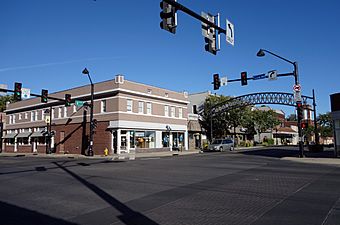Highland Park Historic Business District at Euclid and Sixth Avenues facts for kids
Quick facts for kids |
|
|
Highland Park Historic Business District at Euclid and Sixth Avenues
|
|
 |
|
| Location | Roughly the junction of Euclid and 6th Aves. Des Moines, Iowa |
|---|---|
| Area | 6 acres (2.4 ha) |
| Architect | Wetherell & Gage Hallett & Rawson |
| Architectural style | Late 19th and Early 20th Century American Movements |
| NRHP reference No. | 98000867 |
| Added to NRHP | July 15, 1998 |
The Highland Park Historic Business District at Euclid and Sixth Avenues is a special area in Des Moines, Iowa. It's located in the northern part of the city, right where the Oak Park and Highland Park neighborhoods meet. This historic area, full of old shops and buildings, was added to the National Register of Historic Places in 1998. It's a great example of how towns grew in the past.
Contents
A Look Back: History of the Business District
In the late 1800s, Des Moines was growing fast, especially towards the north. Developers decided to expand even more by creating the Oak Park and Highland Park areas across the Des Moines River. To connect these new areas, they built a bridge at Sixth Avenue. They also added fun places like a zoo and an important school called Highland Park College.
How the Area Grew
The developers worked hard to get a streetcar line built to their new neighborhoods. The Sixth Avenue bridge was very important because it was one of the few bridges over the Des Moines River north of the city. This made Sixth Avenue a main road for farmers bringing their goods into the city.
The business district itself looked like a small downtown area in an Iowa town. It had many different kinds of businesses. There were banks, places for community groups, a fire station, and a post office. You could also find local newspapers, big department stores, and many smaller shops. Most businesses didn't last very long, but some were around for a couple of generations. The very first bank in Des Moines outside of the main downtown area was located here!
Location and Importance
The historic district is mostly along Sixth Avenue. This street forms the border between the Highland Park and Oak Park neighborhoods. Both areas are on a high flat piece of land about three miles north of downtown Des Moines. It's one of the highest spots in the city! The name "Highland Park" was chosen for the district because that neighborhood became more important in the early 1900s.
From the very beginning, the businesses in this area were organized under the "Highland Park Business Men's Club." Most of the historic buildings are clustered around the intersection of Sixth Avenue and Euclid Avenue. Sixth Avenue is the main street, and almost all the buildings face it. All the buildings are made of brick and were built from the early 1890s until just after World War II. Buildings constructed from the 1920s onward were mostly built along Euclid Avenue. At that time, Euclid changed from a residential street into a state highway.
Today, Highland Park is the biggest neighborhood shopping area in Des Moines. Most of the original buildings are still standing, which is pretty cool! Only a few empty lots exist, and some have new buildings on them.
Building Styles: A Journey Through Time
The buildings in this historic district can be grouped into three main styles based on when they were built. Each group shows how architecture changed over time.
Early Buildings (1890s to 1907)
The oldest buildings were built between the early 1890s and 1907. These are the first brick buildings in the area and show the High Victorian style. They often have lots of fancy decorations on their front sides, called façades. Their windows are usually narrow, with special frames around them. The shops often have narrow fronts and use either cast iron or stone to support the storefronts. Some of the last buildings in this group replaced older ones that were destroyed in a big fire in 1906. This was the only major fire in the district. After the fire, new buildings used corbelled brickwork instead of the tin, stone, and terra cotta found on the older buildings.
Middle Period Buildings (1915 to Mid-1920s)
The second group of buildings was built between 1915 and the mid-1920s. During this time, cars became much more important, and the buildings show this change. Their designs often look more horizontal, meaning they stretch out more. The windows are wider and simpler, without as much fancy decoration. The decorative parts were made with stone or concrete inserts and horizontal bands called string courses.
Later Buildings (Late 1920s to Post-WWII)
The last group of buildings was constructed from the late 1920s until just after World War II. Their style continues from the second group but also shows the influence of Modern architectural styles. These buildings use materials like shiny glazed tile, smooth Carrara glass, aluminum, and steel for decoration. Most of the buildings in this last group are only one story tall, except for one.



